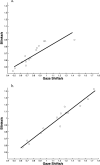Eye blinking in an avian species is associated with gaze shifts
- PMID: 27572457
- PMCID: PMC5004160
- DOI: 10.1038/srep32471
Eye blinking in an avian species is associated with gaze shifts
Abstract
Even when animals are actively monitoring their environment, they lose access to visual information whenever they blink. They can strategically time their blinks to minimize information loss and improve visual functioning but we have little understanding of how this process operates in birds. This study therefore examined blinking in freely-moving peacocks (Pavo cristatus) to determine the relationship between their blinks, gaze shifts, and context. Peacocks wearing a telemetric eye-tracker were exposed to a taxidermy predator (Vulpes vulpes) and their blinks and gaze shifts were recorded. Peacocks blinked during the majority of their gaze shifts, especially when gaze shifts were large, thereby timing their blinks to coincide with periods when visual information is already suppressed. They inhibited their blinks the most when they exhibited high rates of gaze shifts and were thus highly alert. Alternative hypotheses explaining the link between blinks and gaze shifts are discussed.
Figures






Similar articles
-
Fixational eye movement correction of blink-induced gaze position errors.PLoS One. 2014 Oct 21;9(10):e110889. doi: 10.1371/journal.pone.0110889. eCollection 2014. PLoS One. 2014. PMID: 25333481 Free PMC article.
-
Not looking while leaping: the linkage of blinking and saccadic gaze shifts.Exp Brain Res. 1994;100(2):337-44. doi: 10.1007/BF00227203. Exp Brain Res. 1994. PMID: 7813670
-
Target Displacements during Eye Blinks Trigger Automatic Recalibration of Gaze Direction.Curr Biol. 2017 Feb 6;27(3):445-450. doi: 10.1016/j.cub.2016.12.029. Epub 2017 Jan 19. Curr Biol. 2017. PMID: 28111150 Free PMC article.
-
Vision: in the blink of an eye.Curr Biol. 2005 Jul 26;15(14):R554-6. doi: 10.1016/j.cub.2005.07.007. Curr Biol. 2005. PMID: 16051164 Review.
-
The perceptual consequences and neurophysiology of eye blinks.Front Syst Neurosci. 2023 Aug 16;17:1242654. doi: 10.3389/fnsys.2023.1242654. eCollection 2023. Front Syst Neurosci. 2023. PMID: 37654528 Free PMC article. Review.
Cited by
-
Phylogenetically-controlled correlates of primate blinking behaviour.PeerJ. 2021 Feb 17;9:e10950. doi: 10.7717/peerj.10950. eCollection 2021. PeerJ. 2021. PMID: 33643718 Free PMC article.
-
The Various Ways in Which Birds Blink.Animals (Basel). 2023 Nov 26;13(23):3656. doi: 10.3390/ani13233656. Animals (Basel). 2023. PMID: 38067009 Free PMC article.
-
Visual Monitoring Strategies of Sentinels in a Cooperative Breeder.Biology (Basel). 2022 Dec 6;11(12):1769. doi: 10.3390/biology11121769. Biology (Basel). 2022. PMID: 36552280 Free PMC article.
-
A songbird inhibits blinking behaviour in flight.Biol Lett. 2020 Dec;16(12):20200786. doi: 10.1098/rsbl.2020.0786. Epub 2020 Dec 16. Biol Lett. 2020. PMID: 33321068 Free PMC article.
-
A prosocial function of head-gaze aversion and head-cocking in common marmosets.Primates. 2022 Sep;63(5):535-546. doi: 10.1007/s10329-022-00997-z. Epub 2022 Jul 15. Primates. 2022. PMID: 35838928 Free PMC article.
References
-
- Beauchamp G. Animal vigilance: monitoring predators and competitors. (Academic Press, 2015).
-
- Evinger C. A brain stem reflex in the blink of an eye. Physiology 10, 147–153 (1995).
-
- Evinger C., Manning K. A. & Sibony P. A. Eyelid movements. Mechanisms and normal data. Invest Ophthalmol Vis Sci 32, 387–400 (1991). - PubMed
-
- Orchard L. N. & Stern J. A. Blinks as an index of cognitive activity during reading. Integr Physiol Behav Sci 26, 108–16 (1991). - PubMed
Publication types
MeSH terms
LinkOut - more resources
Full Text Sources
Other Literature Sources

